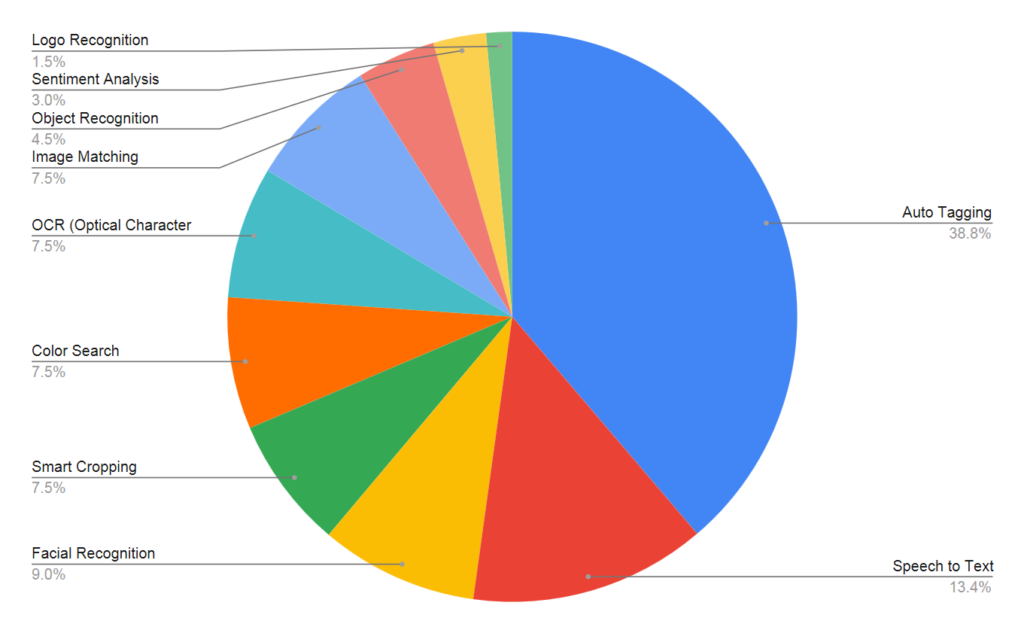The AI Revolution in Digital Asset Management: Promise vs. Reality
This feature article has been contributed by Paul Melcher, visual technology expert and founder of online magazine Kaptur.
In recent years, the buzz surrounding Artificial Intelligence (AI) has reached a fever pitch in nearly every industry, and Digital Asset Management (DAM) is no exception. Vendors and consultants alike have rushed to position themselves as AI experts, painting a future where intelligent algorithms revolutionize how we organize, search, and utilize digital assets. However, a recent study by Santa Cruz Software has shed light on a stark reality: the gap between AI rhetoric and actual implementation in DAM systems is wider than many might expect.
The State of AI in DAM
The study’s findings reveal a landscape where AI integration is still in its infancy. Of the DAM vendors claiming to utilize AI, the vast majority have implemented only the most basic features. Auto-tagging leads the pack, with 78.8% of AI-claiming vendors offering this functionality. This high adoption rate is unsurprising, given auto-tagging’s clear value proposition in reducing manual labor and improving asset searchability. It’s also one of the oldest available.
However, the adoption rates for more advanced AI features tell a different story. Speech-to-text capabilities are present in just 27.3% of systems, while facial recognition appears in only 18.2%. Even more telling is the low implementation of features like object recognition (9.1%), sentiment analysis (6.1%), and logo recognition (3.0%). These numbers suggest that while the DAM industry is eager to embrace the concept of AI, the practical application of more sophisticated AI technologies remains limited.
The Hype vs. The Reality
This disparity between marketing claims and actual implementation raises important questions about the state of AI in the DAM industry. Are vendors overpromising and under delivering? Or is the technology itself not yet mature enough for widespread adoption in DAM systems?
The truth likely lies somewhere in between. While AI technologies have made significant strides in recent years, integrating them effectively into existing DAM systems presents unique challenges. These range from technical hurdles and data privacy concerns to the need for substantial investments in research and development. And converting technology into true value for users.
Moreover, the study’s findings suggest that many vendors may be adopting a cautious approach, focusing on implementing proven, off-the-shelf informative AI technologies that offer immediate, basic benefits to users. This strategy, while perhaps less exciting than the grand visions often painted in marketing materials, may ultimately lead to more stable and reliable DAM systems in the long run. It may also reap less productive outputs.
The Promise of Generative AI
Interestingly, the study also touches upon the nascent field of generative AI, noting its rarity among current DAM offerings. This cutting-edge technology, capable of creating new content or manipulating existing assets, represents both an exciting frontier and a potential disruption to traditional DAM paradigms. While on everyone’s lips, its implementation is, in most cases, limited to an API call to ChatGPT to auto-generate some copy text.
Only a handful of vendors have embraced a truly innovative approach, leveraging GenAI tools such as text-to-image generation, automated background manipulation, and outpainting to lead the charge in creativity and innovation. Surprisingly, despite GenAI’s remarkable capability to comprehend and articulate visual content in natural language, very few have fully harnessed this potential to enhance search functionality. It’s a curious paradox: in an industry whose cornerstone is the search and retrieval of visual assets, one would have anticipated a swifter and more widespread adoption of this game-changing technology.
As generative AI continues to evolve, it could fundamentally reshape how we think about digital assets. When we talk about multichannel, we also need to talk about customization. Instead of merely organizing and retrieving existing content, DAM systems of the future might become creative tools in their own right, capable of customizing and generating on-demand assets tailored to specific needs. Given the volume of communication required by today’s enterprises, this customization must be done at scale and on demand. GenAI is the perfect solution for this.
Looking to the Future
The key for vendors moving forward will be to focus on meaningful implementations that provide tangible benefits to users. This means moving beyond simple generic auto-tagging to explore how AI can enhance asset discovery, streamline workflows, and even assist in content creation, customization, and curation.
For DAM users and potential buyers, the takeaway is clear: look beyond the AI hype and focus on the specific features and capabilities that a system offers. Ask vendors for concrete examples of how their AI implementations improve workflows and deliver measurable benefits. And look for expertise based on actual experience. Too many experts’ “knowledge” of AI is based solely on what they read on social media.
The AI revolution in Digital Asset Management is still in its early stages. While the current reality may not match the lofty promises of marketing materials, the potential for AI to transform DAM is undeniable. As the technology continues to evolve and mature, we can expect to see increasingly sophisticated AI features become standard in DAM systems. Those might quickly and definitely defer to DAM vendors, if not already.
Ultimately, the true measure of AI’s success in DAM will not be the number of features implemented but what they solve. More specifically, on their direct impact on the two most important two metrics powering business decisions: cost saving and profit margins. The journey towards this AI-enhanced future of DAM is just beginning, and it promises to be an exciting ride for all involved.
About Paul Melcher
Paul has over 20 years’ experience working in the visual technology sector, and is the Founder and Director of Melcher System LLC. He also has extensive expertise in generative AI, image recognition and content licensing. You can discover the latest news, technologies and trends in the visual sector via his online magazine Kaptur.
You can connect with Paul via his LinkedIn profile.
Share this Article:

